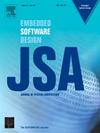SHC-DP: Software–hardware collaborative in-network data placement for hybrid storage systems
IF 4.1
2区 计算机科学
Q1 COMPUTER SCIENCE, HARDWARE & ARCHITECTURE
引用次数: 0
Abstract
Hybrid storage systems increasingly adopt strategic data placement to deliver heterogeneous storage resources at low disk I/O latency for diverse applications. Modern adaptive algorithms with exceptional accuracy, adaptability, and scalability have gradually emerged as one of the mainstream algorithms for data placement. However, existing research predominantly focuses on exploring adaptive data placement algorithms with high placement accuracy, often neglecting the overhead introduced by these algorithms. It significantly compromises the end-to-end latency, a critical factor in determining the quality of service (QoS) for hybrid storage systems. To address this challenge, we introduce SHC-DP, a novel software–hardware collaborative in-network data placement framework. It is proposed to optimize the end-to-end latency for hybrid storage systems by leveraging modern SmartNIC technology. We first analyze the overheads associated with adaptive data placement in detail. Then, a comprehensive hardware/software co-optimization solution is proposed based on the observed insights. It incorporates algorithm acceleration, data transmission and processing optimization, computing and communication task overlapping, and concurrency optimization. Finally, we introduce detailed design and implementation for software/hardware modules and analyze SHC-DP’s performance bounds. Experimental results demonstrate that SHC-DP significantly optimizes end-to-end latency for hybrid storage systems, outperforming the state-of-the-art (SOTA) solution Sibyl by 1.54 .
SHC-DP:用于混合存储系统的软硬件协同网络内数据放置
混合存储系统越来越多地采用战略性数据放置,以低磁盘I/O延迟为各种应用程序提供异构存储资源。现代自适应算法以其优异的精度、适应性和可扩展性逐渐成为数据放置的主流算法之一。然而,现有的研究主要集中在探索具有高放置精度的自适应数据放置算法上,往往忽略了这些算法带来的开销。它极大地降低了端到端延迟,这是决定混合存储系统服务质量(QoS)的关键因素。为了应对这一挑战,我们引入了SHC-DP,一种新颖的软硬件协同网络数据放置框架。提出利用现代SmartNIC技术优化混合存储系统的端到端延迟。我们首先详细分析与自适应数据放置相关的开销。然后,基于观察到的见解,提出了一个全面的硬件/软件协同优化方案。它包括算法加速、数据传输和处理优化、计算和通信任务重叠以及并发优化。最后,介绍了软硬件模块的详细设计与实现,并分析了SHC-DP的性能界限。实验结果表明,SHC-DP显着优化了混合存储系统的端到端延迟,比最先进的(SOTA)解决方案Sibyl高出1.54× ~ 15.18×。
本文章由计算机程序翻译,如有差异,请以英文原文为准。
求助全文
约1分钟内获得全文
求助全文
来源期刊

Journal of Systems Architecture
工程技术-计算机:硬件
CiteScore
8.70
自引率
15.60%
发文量
226
审稿时长
46 days
期刊介绍:
The Journal of Systems Architecture: Embedded Software Design (JSA) is a journal covering all design and architectural aspects related to embedded systems and software. It ranges from the microarchitecture level via the system software level up to the application-specific architecture level. Aspects such as real-time systems, operating systems, FPGA programming, programming languages, communications (limited to analysis and the software stack), mobile systems, parallel and distributed architectures as well as additional subjects in the computer and system architecture area will fall within the scope of this journal. Technology will not be a main focus, but its use and relevance to particular designs will be. Case studies are welcome but must contribute more than just a design for a particular piece of software.
Design automation of such systems including methodologies, techniques and tools for their design as well as novel designs of software components fall within the scope of this journal. Novel applications that use embedded systems are also central in this journal. While hardware is not a part of this journal hardware/software co-design methods that consider interplay between software and hardware components with and emphasis on software are also relevant here.
 求助内容:
求助内容: 应助结果提醒方式:
应助结果提醒方式:


